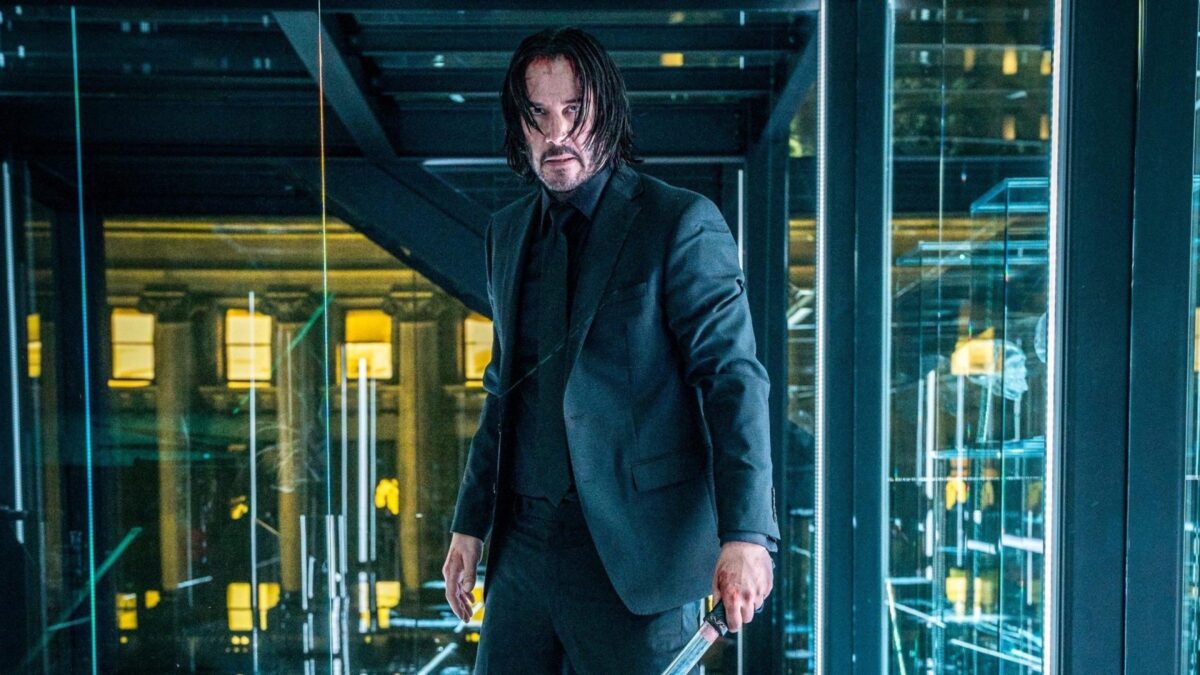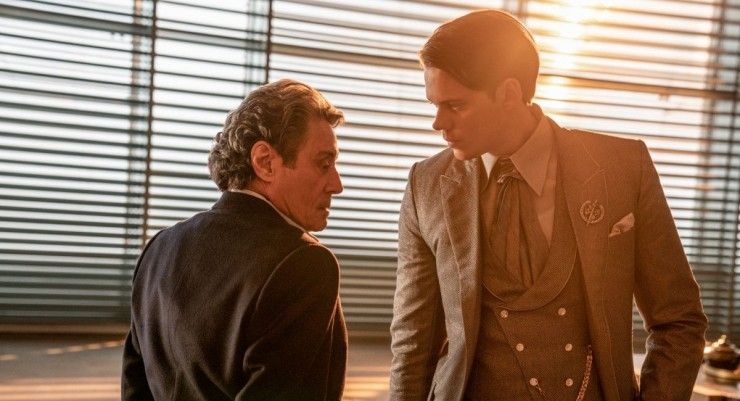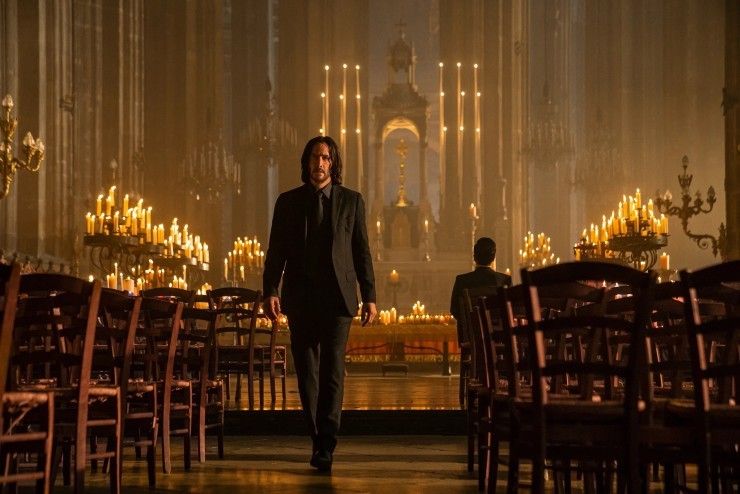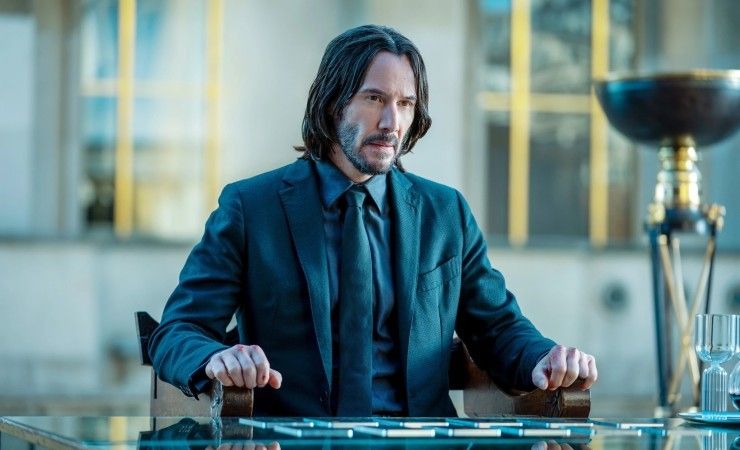
From mayhem to meaningful, John Wick: Chapter 4 editor Nathan Orloff breaks down the edit.
Editor’s note: The following contains John Wick: Chapter 4 spoilers.
Editor Nathan Orloff is the man who helped turn the mayhem in John Wick: Chapter 4 into a dramatic, enchanting dance. The film is the longest entry in the franchise, yet it doesn’t feel like it. Not only is the direction of Chad Stahelski’s action sequences constantly engaging, with the longest action sequence of the film reaching about 40 minutes, but the film’s pacing is confident and unwavering which makes the action meaningful.
This is what you expect from a seasoned editor who has worked on action films before, but John Wick: Chapter 4 was Orloff’s first time taking on a big-budget action film, taking over for editor Evan Schiff who working on the last two installments of the franchise. From small yet meaningful conversations to intricate action sequences, Orloff worked his magic to help create one of the best action films since John Wick (Keanu Reeves) stepped onto the scene.
Orloff sat down with No Film School to take us behind the scenes of how he cut John Wick: Chapter 4.
Editor’s Note: This interview has been edited for length and clarity.
No Film School: How you joined this project, and what about this film made you particularly excited to cut it?
Nathan Orloff: Evan Schiff, a mentor of mine, had cut John Wick: Chapters 2 and 3, and he was unavailable to do this project. But I always knew a little bit about the process and knew how wonderful of a director Chad was to work with. I was also just a fan of the series. I thought they were doing things in action that no other film series are doing. He brought this Hong Kong style of editing to Hollywood that hasn’t been here in a long time.
I got involved because of both a recommendation, my agent put me forward, and Chad apparently interviewed a lot of different editors. Many, many months later, Chad finally told me that one of the reasons that he picked me, was that I hadn’t done one film like this. That he wanted someone and wasn’t going to put the normal action stamp on John Wick but to discover what John Wick could be from an organic process within the film in the post-production process itself, versus saying, “Oh, I’ve cut action how to do it. This is how I’m going to do it.”
NFS: This is technically the first big action film you’ve cut, correct?
Orloff: Yes. I did Ghostbusters: Afterlife, and as a co-editor on that film. I actually was centered, most of the scenes that I cut were all the action and visual effects scenes. So, I was familiar with that. I’ve worked on films like Force Awakens and Star Trek Into Darkness as an assistant capacity. So, I’ve been around them, and around editorial and witnessed it. I did have a little experience, but nothing of this magnitude.
NFS: How do you think Chad Stahelski set you up for success as an editor with your first time really taking over an established franchise?
Orloff: For one, Chad shoots linearly, and that really helps is that he starts at the beginning of a sequence, action-wise, stunt-wise, then just plows forward. They discover any problems they had from the planned stunts. They correct anything, they sort of just keep going forward and modify the blocking, modify the shot list.
I worked on other action sequences in other films where you are creating these piecemeal, “Okay, we have these actors these days facing this direction. Let’s get this part of the scene, that part of the scene,” and you have these tiny little chunks. You don’t have the other half. Three days later, you shoot the other half, and you discovered that they don’t quite work together. This was, at least from a very linear perspective, really helped a lot.
It also helps that Keanu is awesome and that [Chad] casts great stunt people and great stunt coordinators. Chad has a wonderful visual eye. The code name of the film is Caravaggio, his favorite painter. So, he has, between him and Dan Laustsen, created these beautiful, beautiful frames that are actually really hard to cut away from, because they’re so pretty.
NFS: The dialogue is not always what audiences come to the John Wick films for, but it is a vital element of the film. Can you walk me through your approach to cutting the dialogue to match the high pace of the film?
Orloff: In those scenes and really kind of every scene, my process is to kind of go with my gut, find the best performance, what moves me, what makes me feel an emotion, and center around that.
There’s one of my favorite choices was actually in the scene in the Louvre, where Winston (Ian McShane) and the Marquis (Bill Skarsgård) are having this sort of, almost a battle of wits, of he’s trying to convince him. I was watching this footage, and I was watching the Marquis, as he clam up and walked under the painting, and he’s just staring, and Winston is over his shoulder, out of focus, has this long monologue about how you could have all this glory. I was like, “I don’t need to cut to Winston, I can just stay on the Marquis.” Bill is giving me everything I need in terms of his emotion, and the breakdown of his thought process. Then, there’s another point where he just is looking at the painting, and he does this slight smile. It’s those moments of that where I’m like, “Okay, that’s awesome. I’m going to work around this, and figure out how to make this work.” It’s whatever excites me, and it makes me feel something.
Chad and I would also talk a lot about what we call geometric editing or symmetrical editing. It would be this idea of matching sizes or symmetrical ideas, especially let’s say, the rules of the “Duel” card game, where they decide the rules. It’s sort of making sure that the shot sizes are both the same on each side and it’s creating, and then you get closer, and closer, and closer, and then you do those close-up profiles.
It’s a way to ratchet up the tension and create this elegance to the editing that isn’t kind of all over the map. There is times when we do those rules, and then intentionally break the rules, cut back out to reset something, or do something. So, geometric editing is something that I’ve never really had a word to put to it until Chad, where we talked about it a lot, and it was really fascinating and really interesting kind of a part of the way he shoots, and the way he shoots dialogue scenes in particular.

NFS: That’s kind of great that both your visual styles kind of mesh so well together, to accentuate the visual language of this film.
Orloff: Totally. It’s my job to mold myself into what the film and what he wants. I’m already on my next project, and it’s completely different. This film is much more, this camera goes into this shot, and then we cut here. It’s not about geometric editing at all. It’s about more POV, flow, and this and that. And that’s to me, part of the fun part of why to do different genres and do different film aesthetics, and to get challenged in different directions at every turn.
NFS: What is the challenge of the action genre that excites you?
Orloff: To me, the trick about action is about fatigue because more is not more. The stuff about dialogue is, makes me care. I need to make it care. So, there’s action fatigue, action clarity, and using the drama scenes to cement the stakes. To me, if you can accomplish those things, then you’ve created a great action film.
We use music and tried to cut out things to keep the pace up in the last 45 minutes, so that each sequence felt very, very different, even though it’s basically one giant action scene. And then, we had a lot of setups to do that, to do 45 minutes of action and create the stakes and say, John Wick’s freedom is on the line to set up the tracker, to set up Caine, is doing all these things. That allowed us to then have 45 minutes of straight action, structurally as a film. Getting to that point was kind of difficult.
NFS: That whole last section was 45 minutes?
Orloff: Don’t quote me on that exact timing. Some people have said 38 minutes. There might be 38 minutes from the beginning of the street fight through the end of the stairs.
NFS: When you’re cutting these long sequences, you’re talking about action fatigue. How do you make sure that the audience is staying engaged while you are putting these things together?
Nathan Orloff: That’s a matter of just shaving, and shaving, and shaving, and it takes a long time to… I look at it as sort of sifting for gold, where you just keep sifting, and slowly over a course of a lot of time from the assembly, through the director’s cut, through the first preview, you realize what’s working, what’s not. Then, the better other things get, the more obvious what needs to go, goes. That way you get to a size of a sequence. We finished shooting in November of 2021, and we were still making trims to certain shots, in the movie, in January of this year. It takes a while for us to like, the effects are in. Maybe this gag didn’t work as well as we thought it did. Stuff like that. It just takes time. And you can feel it in a preview. You can feel when you lose the audience, and then you can actually feel them reengage. It’s a really actually weird experience, but it’s very useful.
NFS: When you’re sitting in on the previews, what kind of notes are you making? How are you, from the editor’s perspective, watching a preview with a crowd?
Orloff: Honestly, just listening to that crowd. I’m not writing anything down. I am just feeling what everyone’s feeling, and making mental notes of… There are some times when we left things in, where I was like, “I don’t think this is going to work.” And Chad was like, “No, just leave it in and test it.” And it tested great. We’re like, “Great. I’ll never bring that up again. It worked great.” And there are other things that were in that I wanted to lose. It was just basically listening to the vibe.

NFS: Some films are able to make you suspend your disbelief of the logic of how guns would work in real life. How do you, as an editor, help suspend that disbelief?
Orloff: To me, you have to have markers and placements for things that are realistic. So, keeping all the times that – and this goes to Chad in his choreography of when John reloads. That happens enough where you believe what’s going on, so you’re not counting. It’s making sure when you cross-cut, for instance, we cross-cut up to the stairs. If John’s going up the stairs, and all of a sudden you cross-cut to Winston and the Marquis. When you cut back down, he could have reloaded. There’s stuff like that.
I also found that in general, tonally, if somebody was playing comedy, people bought whatever was going on. If we were trying to make it too serious, you’d think John’s dead, or you just kind of don’t buy it. I found laughter a very useful tool in this film.
NFS: One of my favorite standup moments was John falling down the stairs in Paris. I would love to know how that scene looked when they filmed it, and how you kind of built it into this very humorous moment.
Orloff: Honestly, they did these things called spider cams where they set up the camera on a wire and a rig to have it fly down. And the effects that only did was done to remove the wire, the blue screens in the background, and some padding for the stuntman.
That’s another scene where I knew that it had to be funny. That’s a moment where I lingered, especially the second one. When he is falling on the second time. They’ve been very easy to have a tram boom, he did. But it was funnier when it was just like, “Oh, it’s still going.” I kind of look at these films as almost, they’re very Buster Keaton influenced, and they are physical comedies, and I kind of almost look at them as Looney Tunes for adults. So, at that moment when he’s falling down the stairs, we used the sound design to go, he’s very present and close, and then he gets quieter, and more like echoey. And then, we cut to the bottom, he’s far away, and it’s quiet and echoey. To me, it’s just Wile E. Coyote. Again, you’re laughing, and you buy that John’s alive, hopefully.
NFS: That whole sequence is kicked off by a homage to The Warriors. I would love to know, how you pay homage as an editor while still making it its own thing.
Orloff: For something like that, I found to pay direct homage at the beginning, and then have the freedom to use it however I want. So, especially, that was also how it was written to use “Nowhere to Run,” which is used in The Warriors. So, at the very beginning of the sequence, it’s used exactly as in as we had it. Right. As they had it too. And then, once we did that, we’re like, “Great, now we’re in our universe again, and we’re using this tool.”
I love it so much, because when Chad said The Warriors, I was like, “Oh my God, John Wick has been The Warriors since the first time, since the first one.” There are these gangs in New York, and they all dress differently, and they have different… This is where we’ve been heading. It’s such a great homage because it feels like it’s been set up.
Then, after that, it was really wonderful to have this DJ to cross-cut and use when needed, to segue between different parts of the finale, raise stakes, and be part of the character turnaround of the tracker, raising it to 40 million. It was very kind of an important glue that helped bring all these sequences together.
NFS: It’s another really awesome shot, during that Parisian sequence, was that kind of over-the-head, oner shot through the abandoned building. How do you hide those cuts in that sequence? Or was it all just actually one take?
Orloff: It was three takes, and the only separation was the fire bit. If you notice when the kitchen has two walls, the camera goes like this, and that’s where we hid the stitch. It’s just the walls. And the only reason we did that is because of the fire. It was just more of making sure it was safe, and not having to redo the whole take every single time because of the fire bed. No, but that was it. There were only two stitches.
It’s a very impressive shot. The whole thing was a dance. They had a counter 1, 2, 3, and then just played it so everyone knew. Okay. On 17, now I run out. It was choreographed very, very well.
NFS: How did you feel when you saw it for the first time?
Orloff: Oh my gosh. I was so excited, but at the same time, it was still such a blank slate, the whole point of the shot, and it was like, “Oh, this is going to take so much work.” There’s an element for, we don’t use blanks on set. Chad doesn’t think you, I don’t think so either, you don’t need them. Sometimes they use plugged guns with that pop, at least, so you know when the trigger is.
But one secret of some of these films is that, and you’ll never notice, because we obviously, one, we take the sound out, and two, you can’t notice the lips. But a lot of times these stuntmen, when they have the guns, they’re just like, “All right, bam, bam, bam, bam. Bam, bam, bam, bam.” And they’re actually doing that. And it’s actually helpful, because then who’s shooting at what time. So, at some point, sometimes these shots feel like they’re just 10-year-old kids playing in their backyard. “Bam, bam, bam, bam.” It’s just like, okay, all right, this is interesting. It might as well be Star Wars where people have lightsaber fights. It was just kind of adults playing, and having cool stuff that didn’t do anything.
It was the slow process of adding the dragon’s breath and adding the debris. Chad was being obsessive about the papers flying everywhere, and it’s so cool, and it worked out so well, and was so necessary. You have wood chips flying out through walls, and it was a very iterative process, it took a year. But it was exciting to see the potential at the beginning, but it was very much a blank slate.
NFS: What is your favorite sequence of the film for you to edit?
Orloff: My favorite sequence to edit was the club scene, just because I loved cutting that to club music. My favorite sequence that I’m proud of, which was a lot of fun to edit, was the Arc de Triomphe. It was to me by far the most intricate. You have, not only, a driving section, which was a lot. And we had a lot of clarity discussions and worked really hard on making sure that, “Okay, John enters, he’s going the wrong way. All right, a bunch of enemy BMWs is coming, they split off. One’s going the wrong way, one’s going the right way.” And then, you’re just trying to do this screen direction thing of clarity of like, “Oh, John and Chidi are facing off against each other.” It was kind of a challenge to do. And then, the whole sequence outside the car was so much fun. I had so much fun putting a Gestapo sting on that. They were even nice enough to do a re-edit and remix of their song that fit our scene. It was super fun, but a big challenge.

NFS: Is there any moment when you are in the middle of, say, this sequence you’re talking about, where you trust the audience enough to let go of that clarity if we don’t need to know where certain people are within the scene?
Orloff: Yes, it is something to let go of. I usually start by being overly clear, and then dial things back and be like, “I don’t need this. I don’t need that.” Because it is a hard thing to know. You need context for me. It’s not dramatic if you don’t understand. So, it doesn’t mean anything to see a car crash, if you don’t know who’s in it or what’s going on.
NFS: Do you have any advice for any editors who are looking to edit their first action film?
Nathan Orloff: One of the most important things, if you want to get in the industry, if you want to work as an editor, is to be very comfortable being an assistant. I was an assistant for over 10 years. And at the beginning of that process, I thought I was ready to cut movies, even though I was young. After 10 years, I was like, “Oh, I had no idea.” Now I realize I don’t know what I’m doing, and that’s really important.
But spending a decade learning how it’s actually done because cutting films are so much more than just actually cutting the film because it’s all about relationships. Your relationship with a director, your relationship with your team, your relationship with the studio. Those are politics and intricate complicated things that take a long time to understand and build. If someone asked me like, “Oh, can I add you on LinkedIn?” I’m like, “I’m not on LinkedIn. No one in Hollywood’s on LinkedIn. That’s not how you get jobs.” It’s just relationships, and that takes time.
I’d say patience and being comfortable working under people, and learning how it’s really done. Only then, is people are going to trust you.














